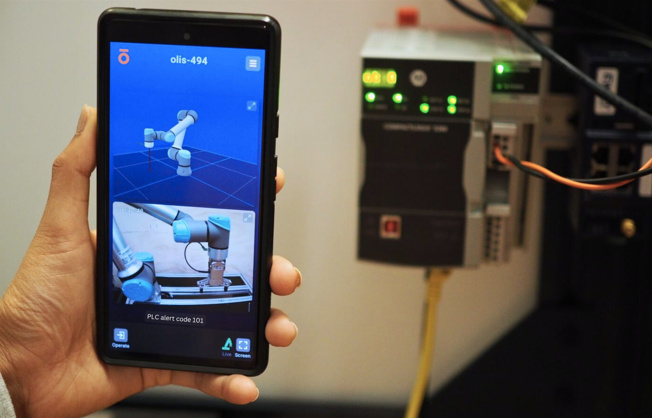Olis Robotics will launch the world’s most comprehensive remote diagnostics solution for industrial automation cells at IMTS 2024 in Chicago, September 9-14, following the addition of powerful new PLC capabilities to its Olis solution.
Olis provides video and telemetry-based diagnostics for industrial cells, enabling technicians to diagnose the root cause of downtime events, such as a robot failure. Immediate access to diagnostic data enables the robotic cell to be debugged quickly and remotely, slashing manufacturer downtime while empowering integrators to take on more business.
Entire robotic cell now monitored, diagnosed and debugged
The company’s new capabilities now extend the power of Olis to entire industrial cells from the PLC to the fingertips of the robotic gripper, including conveyors and other hardware. Using Olis software, users can monitor and set alerts for pre-defined runtime parameters through the PLC, including I/Os, registers, and custom tags. Common uses for PLC tags include measuring Overall Equipment Effectiveness (OEE), monitoring cycle times, and fault detection.
“The PLC often contains important diagnostic data required to understand the causes of unplanned downtime,” says Fredrik Ryden, CEO. “Olis’ new PLC capabilities enable real-time access to that data, effectively closing the loop on video-based diagnostics for industrial automation systems.”
Remote access from Chicago to Seattle
IMTS attendees will be able to experience this first-hand by remotely accessing a machine tending cell in Seattle via the company’s application running on a tablet PC in partner Universal Robots’ IMTS booth #N 236131. the company’s new PLC features are specific to Rockwell Automation’s Allen Bradley PLCs, while robotic arms compatible with Olis include Universal Robots, Kawasaki, and FANUC. In the near future, additional brands of PLCs and robotic arms will be Olis compatible.
‘Unstoppable’ integrators
The PLC orchestrates all of the robots and manages all of the logic for the whole cell. “Sometimes, when a failure occurs, the robots may not even know that there’s a problem,” says Bill Ordakowski, Sales Engineer, adding how early testers of the new PLC
functionality felt greatly empowered by its addition to the Olis solution: “Integrators have told me that they will be ‘unstoppable’ with this new technology. It’s not just the radically reduced downtime that they appreciate, but the extra breadth and control PLC access brings to remote monitoring and diagnostics.”
Solving a notoriously difficult problem
Steve Solack, Controls Engineering Manager at Michigan-based integrator Mission Design & Automation, confirms: “Diagnosing the cause of failure in modern automation cells is notoriously difficult and requires considerable expertise. This is due to the complexity and variety of components involved. With the most crucial diagnostic information often being found in PLC tags and robot data, being able to quickly access such data via Olis’ easy to use interface reduces the time and skill set required to understand the problem, making us more efficient and reducing downtime costs for our customers.”
Key component of future growth
Kilen Multop, IT Director at Idaho-based integrator Kaitech Automation, sees Olis as a key component of the firm’s future growth: ““Kaitech expects to deploy a large number of robot cells to a variety of customers, including a major warehouse club retailer, in the coming years. To support this rapid growth, we need to ensure that robots are deployed quickly and without problems. We will also need to track cell performance for many years to come. Olis enables Kaitech to scale with added confidence by helping with these key elements of automation deployment and management.”
For integrators, the new PLC capabilities enhance their ability to debug a system before shipping, and their ability to successfully monitor the system after deployment and remotely monitor and debug entire industrial cells.
New functionalities improve production throughput
For end users, this means reduced downtime costs –not just in cases of robot failure, but across the entire cell. The new functionality can even be used to maintain and improve standards in production throughput. For example, in an application involving a robot inserting bolts into a part, users could create an alert that indicates when the feeder is running low on bolts. The PLC can then send Olis an alert informing the operator that it’s time to refill the feeder.
“We look forward to showing both manufacturers and integrators at IMTS what a difference Olis can make in reducing overall downtime,” says Fredrik Ryden, CEO, Olis Robotics.
About Olis Robotics
Olis Robotics catalyzes automation adoption by providing users with the best remote-control experience for industrial robots. The company’s flagship ‘Olis’ system enables remote monitoring, control, and troubleshooting of new and fielded industrial robots. When robots fail, Olis provides the facts people need to fix errors and regain control of the production process. Founded in 2013 as a spinout from the University of Washington’s Applied Physics Lab, Olis
Robotics builds on over a decade of telerobotics R&D conducted in collaboration with the U.S. Navy and NASA. Olis Robotics has offices and lab space in Seattle’s Pioneer Square neighborhood.
Learn more about Olis Robotics here, watch how the Olis platform works here and connect on LinkedIn



















